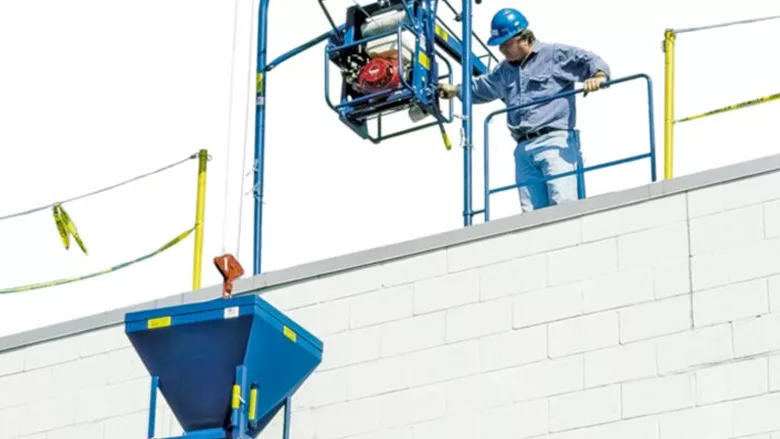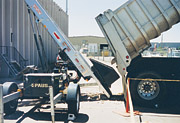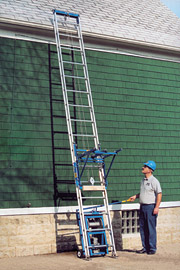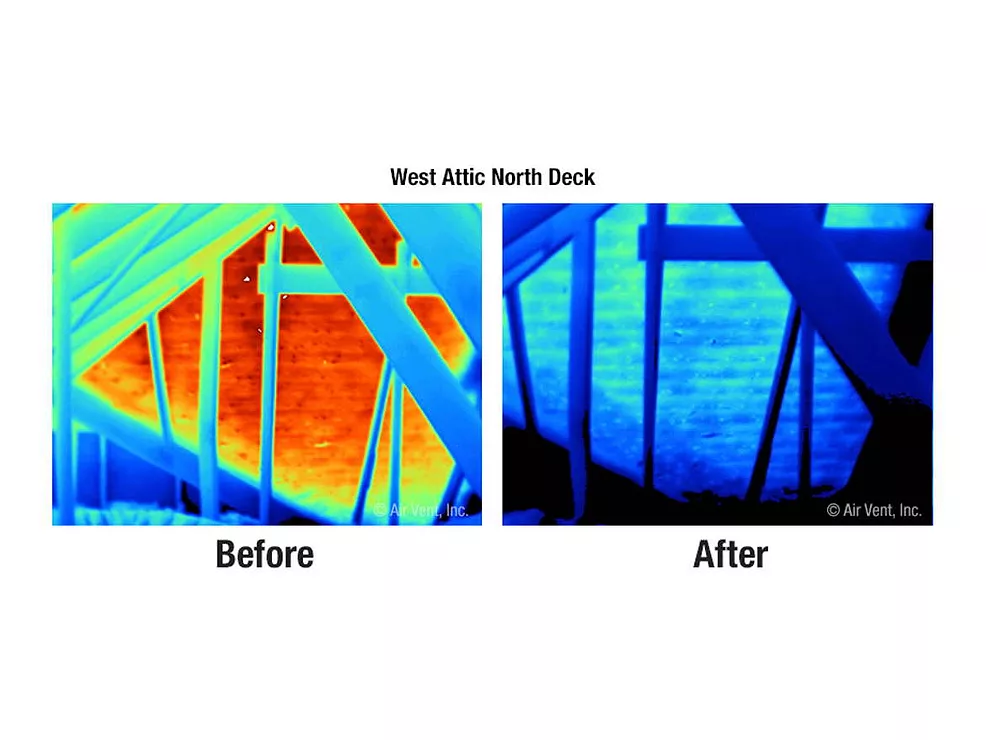High on Safety: Lifting & Hoisting Equipment

Roof-mounted hoists
Roof-mounted hoists are, as the name implies, set up on and operated from the rooftop. The hoist framework supports the winch and power drive, and a wire cable runs from roof to ground to lift materials up.
To adapt the hoist to the many different types of materials used on the roof, accessories are required at the cable end. These accessories include gravel buckets, hoisting forks, hoist slings, and platforms. Roof-mounted hoists can be powered by small gas engines with mechanical power transmissions, electric motors, LPG-powered engines and hydraulic drives.
The advantages of this lifting method include:
1) Portability: Roof-mounted hoists are relatively lightweight and can be transported to the job in any vehicle from a pickup truck on up.
2) Reach: Most ground-operated lifts, even the big expensive ones, are limited to a 10-story reach, but most roof-mounted hoists can go much higher.
3) Production: With lift capacities up to 2,000 pounds and line speeds up to 300 feet per minute, roof-mounted hoists can provide a good size crew with plenty of material to keep the job going smooth.
4) Economy: The initial purchase price and the downstream operating costs of a roof-mounted hoist are very reasonable in comparison to the amount of production of which they are capable, and in comparison to some other equipment.
Safety tips
Here are a few general tips on the proper operation of a roof-mounted hoist, but remember, always refer to the operating instructions furnished with the machine.
- Take care when lifting the hoist frame and power units to the roof and inspect them for damage prior to beginning setup.
- Position the frame as level as possible, never within 15 feet of a power line (this includes the winch cable to the ground).
- Check all engine and hydraulic fluid levels and grease fittings.
- Check the winch cable. If is frayed, pinched, mashed flat or otherwise damaged, replace it.
- When placing ballast on the frame, never use any material such as roll goods or any material that may be taken off and used on the job. Always follow the equipment manufacturer’s recommendation on the amount of ballast to use. The ballast must be in place before any lifting or lowering of materials takes place.
- Many units are furnished with an operator fence that should be installed and checked prior to starting operations. Appropriate personal fall protection systems must be employed in the installation and the operational stage.
- Only fully trained personnel should operate this equipment. A copy of the operating instructions should be available. In addition, the operator must be furnished with complete information about the dimension and weight of all materials to be lifted.
- If load conditions require, use a double line pulley. Never exceed the manufacturer's recommended load limit.
- The operator should always stand at the front end of the hoist, keeping the load in constant observation.
- Always release the brake gradually when lowering a load, and engage gradually when stopping a load. Applying the brake too suddenly can cause a snatch or jerk which could damage the machine, or worse.
- Before starting full operations, test run the unit, checking the clutch and brake. Raise a load a few feet off the ground; make sure the brake holds. This test run should be made just after setting the unit up, and every day prior to lifting the first load.

A 26-foot truck-mounted conveyor on a 20-foot truck bed from Lift Equipment Inc.
Truck-mounted conveyors
The truck-mounted conveyor was designed primarily for use in loading residential roofing. With the conveyor unit mounted to the truck, there is essentially one piece of equipment to move the material from the warehouse to the job site and onto the roof. This eliminates the need for other tow-behind equipment and saves set-up time. A continuous-drive conveyor, even moving at relatively slow speeds, can deliver materials at a rate faster than most crews can load and unload them (up to 720 bundles per hour).
Truck-mounted cranes and knuckle booms can raise more materials up to the roof, but the material must still be unloaded one item at a time on the roof because decks on most residential jobs are too steep or light to handle full pallets of material. A conveyor is generally moved on and off the roof only one time per job, which cuts down on liability exposure. A conveyor mounted on a truck is faster to get up than an unmounted conveyor. On many jobs, this allows the operator to unload materials at the top of the ridge, saving steps and climbing up from the roof edge. On the other hand, the truck-mounted conveyor is limited to a maximum reach of four stories, while truck-mounted cranes and booms can go more than 10.
Basic elements
The basic elements of a conveyor for truck mounting are the boom (the conveyor itself), the turntable (the post that is mounted to the truck body) and the power supply. All of these can be custom fit to meet job requirements.Conveyor lengths range from 20 to 40 feet. The maximum reach of a truck-mounted conveyor is around the same as the boom length. The most popular type is the flat-belted style. Steel conveyors with chains and carrier flights are still available, but have given way in recent years to belted, low-conductive fiberglass units. Belted conveyors are a smoother operation than chains, and require less maintenance than the chain and flight units.
Truck-mounted conveyors may be fitted with a variety of turntables. There are three functions that a hydraulic turntable can perform. First, the boom is elevated hydraulically, a necessary function of the turntable. Second, with a hydraulic cylinder inside the turntable post, the post can be raised and lowered. This allows the boom to be raised high above the truck body for loading materials under it. When the unit is on the job and in position for loading, the post may be lowered to a more comfortable loading height for the operator. Third, the hydraulic turntable may be built with a hydraulic rotation feature, allowing the boom to be turned under power. Since the booms rotate easily when they are on flat ground, this is mostly a safety feature that offers greater operator control.
Matching truck and conveyor
There are many more truck and body options than conveyors and it is essential to make a good match when preparing to put a complete package together. Some equipment distributors routinely furnish turnkey units. A competent truck body or conveyor equipment distributor should be able, with assistance from the truck and conveyor manufacturers, to engineer a suitable package to match your needs. Consider truck, body size and capacity that will match not only load requirements but also the requirements of the conveyor and turntable.
One other feature to carefully consider is outriggers for stabilizing the truck and body during operation. Smaller conveyors mounted on very heavy-duty trucks may not require outriggers, but most combinations will. Outriggers will provide not only a safer operating environment, but also should help the longevity of the overall unit by stabilizing and leveling the unit during operation, reducing vibration and uneven wear.
Maintenance and operation
Here are a few general tips to good maintenance and operation of a truck-mounted conveyor:
- Maintain all safety and warning labels on the conveyor.
- Perform no maintenance on the unit while it is in operation.
- Allow only qualified persons to perform maintenance.
- Routinely inspect the unit for damage, broken welds, missing pins, loose bolts, nuts, etc.
- Check and maintain all fluid levels.
- Replace all leaky or damaged hoses.
- Keep all sprockets in alignment and roller chains lubed.
- Do not grease the carrier chains. Use only a light lubricant or rust inhibitor.
- Keep all chain and belt take-ups adequately tightened.
- Regularly fill all grease fittings, especially the turntable bearings.
- Set up the unit on firm, level ground and always use outriggers.
- Never operate the conveyor in high winds or dusty conditions.
- Do not operate a conveyor in need of maintenance or with any guards missing.
- Do not reach through any part of the conveyor when it is operating.
- Never allow the boom within 10 feet of any power line (always assume that an overhead wire is live).
- Never move the truck unless the conveyor is down and secured.

The Versa-Lift 600 from Garlock Equipment Co. Inc.
Telescopic elevators
From a safety perspective, the elevator’s design offers many features and capabilities to keep the job site running smoothly. When it comes to setup and repositioning the elevator, you can literally set up against a building and be ready to lift equipment or materials in 15 to 20 minutes. The boom raises and extends hydraulically to the roof edge. The operator simply lowers the outriggers in place and positions the boom against the building.
Another important safety design feature of the elevator is in its ability to deliver materials and/or equipment 6 feet or more in from the roof edge. During the lifting process, as the load comes up level to the roof edge, a self-contained ramp is laid down on the roof and the load rolls well in from the roof edge. This feature reduces the need for reaching out over the roof edge to handle loads. Some models are also equipped with built-in guardrails for additional roof edge protection.
While belted gravel conveyors work great for ballasting, they can do so only up to 40 to 50 feet. Elevators can deliver ballast nearly three times as high plus lift 90 percent of rooftop equipment and materials as well. All that is typically required for setup on the ground is a 10-foot-by-20-foot area. This compact area makes job sites more efficient by reducing the area around which everyone else must work.
Most elevators also come equipped with an auto-lock system on the carriage and hydraulic brake. Much like a hydraulic hoist, the elevator requires hydraulic pressure from the motor to hold the brake open and allow the load to move up or down. If for any reason the hydraulic pressure is lost, the brake locks on instantly. Also, in the unlikely event that a cable breaks, the carriage that is carrying the load has automatic locks that instantly grab the rails and prevent the load from moving. Having a clear line of sight of the load is key to safety no matter what equipment is being used.
Elevators come in two basic configurations: a straight boom and an articulating or knuckle boom. The straight model, as the name implies, provides a rigid boom that will only allow placement of the boom against the face of the building. The knuckle boom model allows the boom to extend past the roof edge and knuckle or bend over into the roof area. The capability of the knuckle feature is especially important on pitched roofs or flat roofs with backset roofs because it can eliminate the need for second and third handling of materials or equipment. Any time a load can be positioned close to where the work is actually being completed, the better it is for safety and efficiency.

The Pro400 Platform Hoist from Reimann & Georger Corp.
Portable hoists for residential roofs
Platform or track hoists are light and portable enough to be easily carried in a pickup truck. They can be moved around the buildings as work progresses, which is convenient when working on scaffolding. The basic rig consists of a track, a platform and a hoist. The track is an aluminum frame resembling, but not to be confused with, a ladder. Tracks come in several sizes and can be joined with other track sections for the proper amount of reach. Track sections are joined by splice plates that slide in the sides of the tracks, assuring a snug fit and straight overall track.
The platform rides up and down the track delivering material to the roof. The platform is fitted with a series of rollers that allow it to roll easily up and down the track while remaining on the groove. The power hoist is mounted to the rungs of the lower backside of the track. The hoist has a cable that runs up to the top of the track and back down to the platform, allowing it to be pulled up and lowered down. Some track hoists have a double line set up where the cable runs through another pulley on the platform and back to the top of the track. This double line allows for less strain on the power unit while lifting a heavier load.
Track hoists come in many models with load capacities ranging from 200 to 400 pounds. The shortest rig comes with 16 feet of track while the maximum recommended track length is 44 feet.
The right choice of power could be the most important. Gas- and electric-powered hoists are belt driven with a mechanical “dead man”-type braking system, either a disk brake or a brake rope. If you choose electric, you will always need to have a good electricity source on your jobs, one that carries the proper voltage and amperage through a nominal length of a rated extension cord. With hydraulic power, the need for vee belts, pulleys and mechanical braking devices are eliminated, reducing downtime and maintenance expense. Hydraulic hoists also run more smoothly and are easier to operate and control.
In addition to the standard platform, options such as gravel hoppers and panel-carrier attachments are available. Other features include an emergency stop that activates if the cable should snap or slip off a pulley, and track supports used to catch materials at the top and guide them away from the platform and roof edge.
Safety tips
- Always refer to the manufacturer’s operating instructions
- When setting up, choose a flat, firm place away from doors and windows if possible.
- Keep the hoist away from any foot traffic and flag the area to each side and rear of the machine with ropes and “keep away” signs.
- Make sure that the hoist track is set up at the angle recommended by the manufacturer. The track is only a guide and cannot be used at low angles. Using the wrong angle will result in excess or uneven wear on the track and platform.
- Prior to operating, always check the engine fluid levels, belts and pulleys, brake, track and hoist cable. If the hoist cable is kinked, pinched or frayed, it should be replaced immediately. Also, pull the cable off the winch drum periodically to inspect it carefully and to rewind it back into the drum evenly.
Looking for a reprint of this article?
From high-res PDFs to custom plaques, order your copy today!



